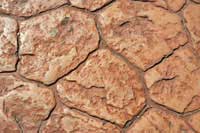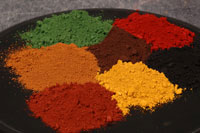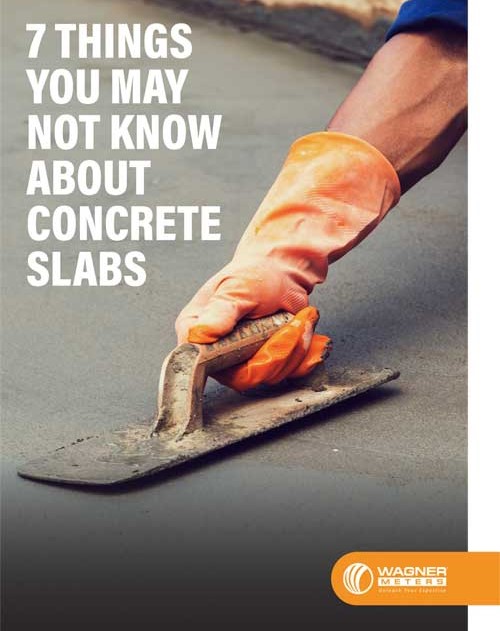Moisture at Work in Your Decorative Concrete
Decorative concrete has become one of the key places where durability and aesthetics meet in the building industry today. It’s a rather broad category and covers everything from floors to countertops, patios and fixtures, walls and artistic installations. Transforming basic concrete into a structural work of art can include stamping, dying, overlays, polishing, engraving, staining, grinding, waxing and more. Decorative concrete applications are continuing to grow in popularity as the range of finishes and looks continues to expand. The need for accurate moisture measurement hasn’t changed.
A Variety of Looks

- Stamped concrete
Stamped concrete imprints concrete surfaces to give them the look of almost any imaginable material – wood, cobblestone, slate, or brick, and can have features or textural images (like fossils or leaves) added for visual impact. - Staining
Finished concrete can be stained with a variety of applications to color or provide visual impact for concrete surfaces. Acid-based stains color through a chemical process, while water-based, acrylic or epoxy finishes add color by bonding with the surface. - Cement overlays
Overlays provide a thin layer of cementitious material that bond with the concrete surface. They are effective for leveling, regarding or repairing surface cracks and can be given a variety of finishes as well. - Surface finishes
Polishing, grinding or engraving are post-drying techniques that can provide decorative detail or a smooth-as-glass finish. - Painting
Obviously, painting concrete can range from simple colors to elaborate murals and details.
Finishes can also be combined in a huge variety of ways to provide unique finishes that range from rustic to highly sophisticated and will last for a very long time.
The Same Moisture Measurement
Along with a myriad of technical, chemical and artisan skills, moisture plays an important role in decorative concrete installation and finishing. Uncontrolled moisture can cause significant issues in any concrete installation if not handled competently and knowledgeably. With decorative concrete, a high-level understanding of moisture’s role is critical to producing the expected results and the long-lived beauty that make it such an attractive option for businesses and homeowners alike.
How does moisture affect your decorative concrete project? Here are four things you and your contractor will need to consider:
- Consistent water to cement ratios

While this is true of any concrete project, in decorative concrete consistency is key. Particularly if a colored pigment is being added, or if multiple batches are being poured, maintaining a consistent cement-to-water ratio, along with other aggregates or additives for each concrete mix means that all areas of the project will have more uniform drying rates, stamping performance, finish colors, and surface conditions. Decorative concrete mixes frequently contain a higher ratio of water to encourage smooth pouring and assured curing- the chemical changes that “set” the concrete. That moisture will need time to evaporate away as the concrete dries. - Curing and drying rates
During both the curing and the subsequent drying process of concrete, the rate at which moisture evaporates from the surface can impact the final surface texture and workability. Potential appearance flaws like delamination, carbonation or efflorescence are all linked to the rate at which moisture leaves the drying concrete. Adding a color mix makes controlling the curing and drying rates even more critical for even final color uniformity and appearance. A recent article by Concrete Décor Magazine recommends a color-match curing membrane- the permeability of a curing membrane controls the rate at which moisture can escape the surface and still protects it from contaminants. For internal decorative concrete, controlling ambient conditions with functional HVAC systems can help as well. - The moisture tolerance of your chosen finish
Different finishes, either inherently or by design, can tolerate different moisture levels. If you apply a finish before the concrete is adequately dry, however, there may be trouble ahead. Blistering, lost adhesion, cracking, fading and mineral stains are only a few of the potential problems if moisture has not reached the appropriate level for your decorative concrete finish. Knowing the correct manufacturer’s recommended product tolerance will help you gauge when the concrete has reached the appropriate moisture level to proceed with the finish. Which will require… - Accurate relative humidity (moisture) testing
The majority of concrete projects dry from one side (floors, walkways, counters that are form poured), which means that moisture must rise from the bottom of the slab to the top, where it can evaporate away. It’s a process that can be influenced by a number of factors, including the initial mix water content, the ambient drying conditions and more. Because of this, no rule-of-thumb is completely adequate to determine the internal moisture content of a concrete slab. Surface-based testing will not get you there either for concrete projects of any substantial depth.

Free Download – 7 Things You May Not Know about Concrete Slabs
To accurately measure the moisture content of concrete slabs, relative humidity (RH) testing provides a tested and proven method for determining the final moisture levels of a concrete slab if the surface were to be sealed at that point in time. Once a concrete surface is sealed by any sort of finish or flooring, the moisture will continue to disperse through the slab until it has equalized. If that moisture level is above your finish’s moisture tolerances, it will mean trouble. Any measurement taken at the surface cannot accurately measure the final internal moisture content, and therefore, cannot tell you if it’s safe to move ahead with your decorative concrete finish and/or sealant. RH testing, like the Rapid RH®, provides an accurate measurement of concrete’s moisture content so that you can be sure your decorative concrete projects will retain their beauty for years to come.
Jason has 20+ years’ experience in sales and sales management in a spectrum of industries and has successfully launched a variety of products to the market, including the original Rapid RH® concrete moisture tests. He currently works with Wagner Meters as our Rapid RH® product sales manager.
Related Posts via Taxonomies
Last updated on June 21st, 2022




Awesome, thank you for even taking the time to even share this great concrete information Jason! Definitely will be reading more of your articles, keep up the great work!
Weather is a tough part of how and when to install any kind of concrete, let alone decorative or stamped concrete. It makes being a contractor in the midwest an interesting job! Thanks for the helpful tips!
I wanted to add some moisture content to my driveway that I’m planning. It will have decorative concrete and I’m planning to add some color into it but I was kinda worried about how it will affect the finish.